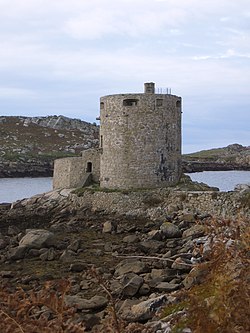Cromwell's Castle
| Cromwell Castle | |
|---|---|
| Tresco in the Isles of Scilly | |

The castle, seen from the land
|
|
| Coordinates | 49°57′42″N 6°21′02″W / 49.9616°N 6.3505°WCoordinates: 49°57′42″N 6°21′02″W / 49.9616°N 6.3505°W |
| Grid reference | grid reference SV881159 |
| Type | Artillery tower |
| Height | 15.1 metres (50 ft) |
| Site information | |
| Controlled by | English Heritage |
| Site history | |
| Materials | Stone rubble |
Cromwell's Castle is an artillery fort overlooking New Grimsby harbour on the island of Tresco in the Isles of Scilly. It comprises a tall, circular gun tower and an adjacent gun platform, and was designed to prevent enemy naval vessels from entering the harbour. The castle was built in two phases; Sir Robert Blake constructed the tower between 1651 and 1652 in the aftermath of the Parliamentary invasion of the islands at the end of the English Civil War, and Master Gunner Abraham Tovey added the gun platform during the War of Jenkins' Ear around 1739. The tower fell into disuse soon afterwards, and in the 21st century is managed by English Heritage and open to visitors.
Cromwell's Castle is an artillery tower, built by Sir Robert Blake following the Parliamentary invasion of the Isles of Scilly in 1651. During the English Civil War between 1642 and 1646, the inhabitants of the Isles had been Royalist supporters of King Charles I, and rebelled against Parliament in favour of Charles in 1648. Tresco became a base for Royalist privateers and Parliament became concerned that the Dutch, then hostile to England, might exploit the situation, or that Royalist Irish forces might use the islands for an attack on England. In 1651 Parliament sent Robert Blake and a naval force to retake the island, which had been fortified by the Royalists.
Having established control of the islands, between 1651 and 1652 Blake constructed Cromwell's Castle on Tresco, named after Oliver Cromwell, the Parliamentary leader. It was intended to protect the deep water entrance to New Grimsby harbour on the west side of the island, a route which could also allow enemy vessels access through to the other Scilly Isles. The Parliamentarian forces were particularly concerned about any potential Dutch attack.
...
Wikipedia

